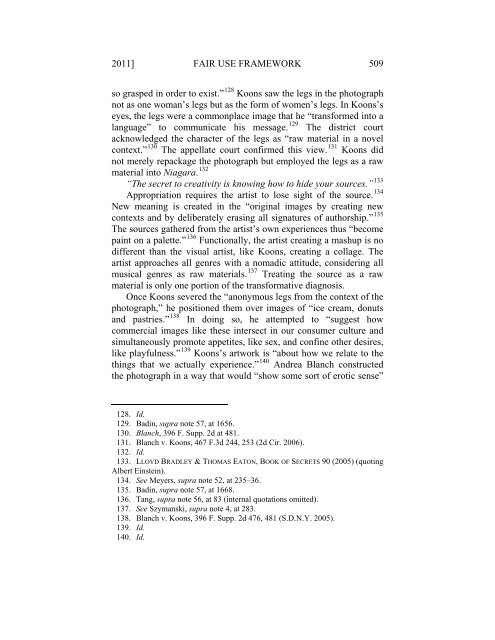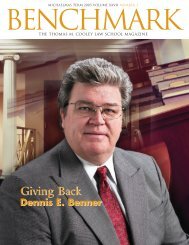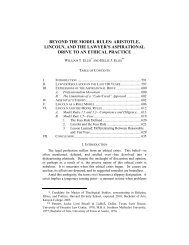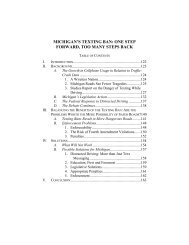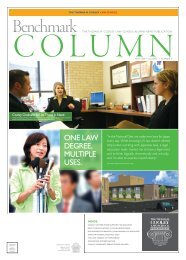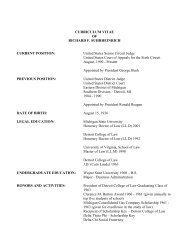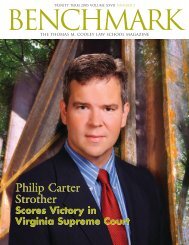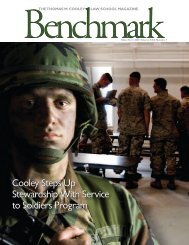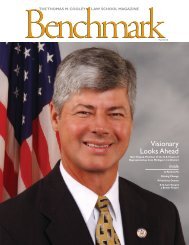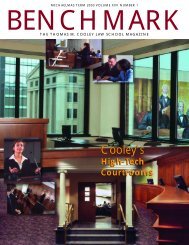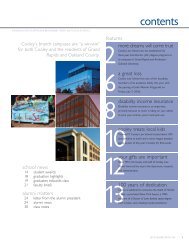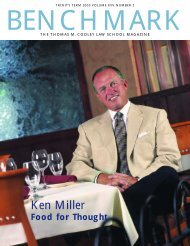Blanch It, Mix It, Mash It - Thomas M. Cooley Law School
Blanch It, Mix It, Mash It - Thomas M. Cooley Law School
Blanch It, Mix It, Mash It - Thomas M. Cooley Law School
You also want an ePaper? Increase the reach of your titles
YUMPU automatically turns print PDFs into web optimized ePapers that Google loves.
2011] FAIR USE FRAMEWORK 509<br />
so grasped in order to exist.” 128 Koons saw the legs in the photograph<br />
not as one woman’s legs but as the form of women’s legs. In Koons’s<br />
eyes, the legs were a commonplace image that he “transformed into a<br />
language” to communicate his message. 129 The district court<br />
acknowledged the character of the legs as “raw material in a novel<br />
context.” 130 The appellate court confirmed this view. 131 Koons did<br />
not merely repackage the photograph but employed the legs as a raw<br />
material into Niagara. 132<br />
“The secret to creativity is knowing how to hide your sources.” 133<br />
Appropriation requires the artist to lose sight of the source. 134<br />
New meaning is created in the “original images by creating new<br />
contexts and by deliberately erasing all signatures of authorship.” 135<br />
The sources gathered from the artist’s own experiences thus “become<br />
paint on a palette.” 136 Functionally, the artist creating a mashup is no<br />
different than the visual artist, like Koons, creating a collage. The<br />
artist approaches all genres with a nomadic attitude, considering all<br />
musical genres as raw materials. 137 Treating the source as a raw<br />
material is only one portion of the transformative diagnosis.<br />
Once Koons severed the “anonymous legs from the context of the<br />
photograph,” he positioned them over images of “ice cream, donuts<br />
and pastries.” 138 In doing so, he attempted to “suggest how<br />
commercial images like these intersect in our consumer culture and<br />
simultaneously promote appetites, like sex, and confine other desires,<br />
like playfulness.” 139 Koons’s artwork is “about how we relate to the<br />
things that we actually experience.” 140 Andrea <strong>Blanch</strong> constructed<br />
the photograph in a way that would “show some sort of erotic sense”<br />
128. Id.<br />
129. Badin, supra note 57, at 1656.<br />
130. <strong>Blanch</strong>, 396 F. Supp. 2d at 481.<br />
131. <strong>Blanch</strong> v. Koons, 467 F.3d 244, 253 (2d Cir. 2006).<br />
132. Id.<br />
133. LLOYD BRADLEY & THOMAS EATON, BOOK OF SECRETS 90 (2005) (quoting<br />
Albert Einstein).<br />
134. See Meyers, supra note 52, at 235–36.<br />
135. Badin, supra note 57, at 1668.<br />
136. Tang, supra note 56, at 83 (internal quotations omitted).<br />
137. See Szymanski, supra note 4, at 283.<br />
138. <strong>Blanch</strong> v. Koons, 396 F. Supp. 2d 476, 481 (S.D.N.Y. 2005).<br />
139. Id.<br />
140. Id.


